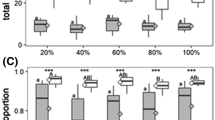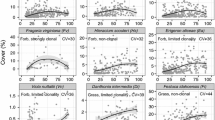Abstract
To investigate how the composition of wetland communities changes over time in response to altered light regimes, experimental communities of five Carex and four grass species were subjected to artificial shading (continuous or seasonal) in a three-year field experiment. Shoot number and size was measured after six weeks, and shoot biomass was harvested five times during the experiment. Communities were initially dominated by three grass species in all treatments, but subsequently, the Carex species increased and reached dominance in the control plots, whereas grasses remained dominant in the shaded plots. Shading had no effect on the biomass of communities or of single species in the first year. In the second year, community biomass was still unaffected, but shading reduced the biomass of three Carex species and also reduced species diversity. In the third year, shading reduced community biomass and all Carex species, but not species diversity. The greater shade tolerance of the grasses could not be explained by differences in morphological plasticity: after six weeks of growth all species had increased shoot height in response to shade by 40–70%. Grasses were hardly more plastic than Carex species. We propose that the long-term success of the Carex species in full light was due to a high allocation of biomass to belowground parts, which may have reduced losses caused by repeated harvesting of shoots (a simulation of management in productive wet meadows). Shading probably caused the Carex plants to change their allocation pattern, and thus prevented their progressive increase.
Similar content being viewed by others
References
Aerts R. and de Caluwe H. (1995). Interspecific and intraspecific differences in shoot and leaf life-span of 4 Carex species which differ in maximum dry-matter production. Oecologia 102:467–477
Alonso I. and Hartley S.E. (1998). Effects of nutrient supply, light availability and herbivory on the growth of heather and three competing grass species. Plant Ecology 137:203–212
Anten N.P.R. and Hirose T. (1999). Interspecific differences in above-ground growth patterns result in spatial and temporal partitioning of light among species in a tall-grass meadow. Journal of Ecology 87:583–597
Belcher J.W., Keddy P. and Twolan-Strutt L. (1995). Root and shoot competition intensity along a soil depth gradient. Journal of Ecology 83:673–682
Berendse F., Elberse W.T. and Geerts R.H.M.E. (1992). Competition and nitrogen loss from plants in grassland ecosystems. Ecology 73:46–53
Boeye D., Verhage B., Van Haesebroeck V. and El-Kahloun M. (1999). Phosphorous fertilization in a phosphorous-limitated fen: effects of timing. Applied Vegetation Science 2:71–78
Boeye D., Verhagen B., Van Haesebroeck V. and Verheyen R.F. (1997). Nutrient limitation in species-rich lowland fens. Journal of Vegetation Science 8:415–424
Bollens U. 2000. Effects of nutrient inputs and water regime on wetland vegetation and the performance of wetland species. Dissertation ETH No. 13 560, ETH, Zürich.
Cahill J.F. (1999). Fertilization effects on interactions between above- and belowground competition in an old field. Ecology 80:466–480
Campbell B.D., Grime J.P., Mackey J.M.L. and Jalili A. (1991). The quest for a mechanistic understanding of resource competition in plant communities: the role of experiments. Functional Ecology 5:241–253
Corré W.J. (1983). Growth and morphogenesis of sun and shade plants. I. The influence of light intensity. Acta Botanica Neerlandica 32:49–62
Edelkraut K. and Güsewell S. (2001). Effects of light and nutrient supply on the growth and competitive ability of five Carex species. Bulletin of the Geobotanical Institute ETH 67:41–56
Edelkraut K. 2004. Interacting effects of resources and competition on the growth of wetland plants. Dissertation ETH No. 15250, ETH Zürich.
Eek L. and Zobel K. (1997). Effects of additional illumination and fertilization on seasonal changes in fine-scale grassland community structure. Journal of Vegetation Science 8:225–234
El-Kahloun M., Boeye D., Verhagen B. and Van Haesebroeck V. (2000). A comparison of the nutrient status of Molinia caerulea and neighbouring vegetation in a rich fen. Belgian Journal of Botany 133:91–102
Foster B. (2000). Competition at the population level along a standing crop gradient: a field experiment in successional grassland. Plant Ecology 151:171–180
Foster B.L. and Gross K.L. (1998). Species richness in a successional grassland: Effects of nitrogen enrichment and plant litter. Ecology 79:2593–2602
Fransen B. and De Kroon H. (2001). Long-term disadvantages of selective root placement: root proliferation and shoot biomass of two perennial grass species in a 2 year experiment. Journal of Ecology 89:711–722
Goldberg D.E. and Novoplansky A. (1997). On the relative importance of competition in unproductive environments. Journal of Ecology 85:409–418
Güsewell S. 1997. Evaluation and management of fen meadows invaded by Phragmites australis. Diss. ETH No 12′428, Zürich.
Güsewell S. and Edwards P.J.E. (1999). Shading by Phragmites australis: a threat for species-rich fen meadows?. Applied Vegetation Science 2:61–70
Güsewell S. 2005. Responses of wetland graminoids to the relative␣supply of nitrogen and phosphorus. Plant Ecol. 176: 35–55.
Henry H. and Aarssen L. (1997). On the relationship between shade tolerance and shade avoidance strategies in woodland plants. Oikos 80:575–582
Hess H.E., Landolt E. and Hirzel R. (1991). Bestimmungsschlüssel zur Flora der Schweiz und angrenzender Gebiete. 3 edn. Birkhäuser, Basel
Hirose T. and Werger M.J. (1995). Canopy structure and photon flux partitioning among species in a herbaceous plant community. Ecology 76:466–474
Jensen K. and Schrautzer J. (1999). Consequences of abandonment for a regional fen flora and mechanisms of successional change. Applied Vegetation Science 2:79–88
Keddy P.A. (1989). Effects of competition from shrubs on herbaceous wetland plants: a 4 year field experiment. Canadian Journal of Botany 67:708–716
Kielland K. and Chapin F.S., III (1994). Phosphate uptake in arctic plants in relation to phosphate supply: the role of spatial and temporal variability. Oikos 70:443–448
Konings H., Koot E. and Wolf A.T. (1989). Growth characteristics, nutrient allocation and photosynthesis of Carex species from floating fens. Oecologia 80:111–121
Kotowski W., van Andel J., van Diggelen R. and Hogendorf J. (2001). Responses of fen plant species to groundwater level and light intensity. Plant Ecology 155:147–156
Landolt E. (1977). Ökologische Zeigerwerte zur Schweizer Flora. Veröffentlichungen des Geobotanischen Instituts ETH, Stiftung Rübel, Zürich 64:1–208
Leps J. (1999). Nutrient status, disturbance and competition: an experimental test of relationships in wet meadow copy. Journal of Vegetation Science 10:219–230
Liira J. and Zobel K. (2000). Vertical structure of a species-rich grassland canopy, treated with additional illumination, fertilization and mowing. Plant ecology 146:185–195
McKenna M. and Houlé G. (1999). The effect of light on the growth and reproduction of Floerkea proserpinacoides. New Phytologist 141:99–108
Naumburg E., DeWald L.E. and Kolb T.E. (2001). Shade responses of five grasses native to southwestern US Pinus ponderosa forests. Canadian Journal of Botany-Revue Canadienne De Botanique 79:1001–1009
Olff H. (1992). Effects of light and nutrient availability on dry matter and N allocation in six successional grassland species: Testing for resource ratio effects. Oecologia 89:412–421
Poorter H. and Nagel O. (2000). The role of biomass allocation in the growth response of plants to different levels of light, CO2, nutrients and water: a quantitative review. Australian Journal of Plant Physiology 27:595–607
Poorter H. and Van der Werf A. (1998). Is inherent variation in RGR determined by LAR at low irradiance and by NAR at high irradiance? A review of herbaceous species. In: Lambers H., Poorter H. and Van Vuuren M.M.I. (eds), Inherent variation in plant growth. Physiological mechanisms and ecological consequences. Backhiys Publishers, Leiden, pp. 309–336
Rajaniemi T.K. (2002). Why does fertilization reduce plant species diversity? Testing three competition-based hypotheses. Journal of Ecology 90:316–324
Ryser P. and Eek L.(2000). Consequences of phenotypic plasticity vs. interspecific differences in leaf and root traits for acquisition of aboveground and belowground resources. American Journal of Botany 87:402–411
Schieving F. and Poorter H. (1999). Carbon gain in a multispecies canopy: the role of specific leaf area and photosynthetic nitrogen-use efficiency in the tragedy of the commons. New Phytologist 143:201–211
Schippers P., Snoeijing I. and Kropff M.J. (1999). Competition under high and low nutrient levels among three grassland species occupying different positions in a successional sequence. New Phytologist 143:547–559
Schütz W. and Rave G. (1999). The effect of cold stratification and light on the seed germination of temperate sedges (Carex) from various habitats and implications for regenerative strategies. Plant Ecology 144:215–230
Sims D.A. and Pearcy R.W. (1993). Sunfleck frequency and duration affects growth rate of the understorey plant, Alocasia macrorrhiza. Functional Ecology 7:683–689
Spacková I., Kotorová I. and Leps J. (1998). Sensitivity of seedling recruitment to moss, litter and dominant removal in an oligotrophic wet meadow. Folia Geobotanica et Phytotaxonomica 33:17–30
Stuefer J.F. and Huber H. (1998). Differential effects of light quantity and spectral light quality on growth, morphology and development of two stoloniferous Potentilla species. Oecologia 117:1–8
Thornton B. (1991). Effect of nutrition on the short-term response of Molinia caerulea to defoliation. Annals of Botany 68:569–576
Twolan-Strutt L. and Keddy P.A. (1996). Above- and belowground competition intensity in two contrasting wetland plant communities. Ecology 77:259–270
van Duren I., Pegtel D., Aerts B. and Inberg J. (1997). Nutrient supply in undrained and drained Calthion meadows. Journal of Vegetation Science 8:829–838
Wardle D., Bonner K., Barker G., Yeates G., Nicholson K., Bardgett R., Watson R. and Ghani A. (1999). Plant removals in perennial grassland: Vegetation dynamics, decomposers, soil biodiversity, and ecosystem properties. Ecological Monographs 69:535–568
Weihe P.E. and Neely R.K. (1997). The effects of shading on competition between purple loosestrife and broad-leaved cattail. Aquatic Botany 59:127–138
Wheeler B.D. and Shaw S.C. (1991). Above-ground crop mass and species richness of the principal types of herbaceous rich-fen vegetation of lowland England and Wales. Journal of Ecology 79:285–301
Yoshie F. (1995). Interhabitat variation in growth characteristics of temperate herbaceous perennials. Canadian Journal of Botany 73:735–745
Zobel K. (2001). On the species-pool hypothesis and on the quasi-neutral concept of plant community diversity. Folia Geobotanica et Phytotaxonomica 36:3–8
Acknowledgements
We are most thankful to Dieter Ramseier and the Stiftung Seebachtal, who made the site available for this experiment and provided the seeds as well as valuable advice and support. We also thank Peter J. Edwards for advice on the experiment and R. Aerts for helpful comments on the manuscript. Phillipp Hafliger, Hanspeter Suter and Mark van Kleunen provided substantial help in establishing the field plots, and Claude Théato, Regula Ott and Kathrin Jaag efficiently helped in maintaining the experiment and collecting data. The research was funded through a grant from the Swiss Federal Institute of Technology, Zürich.
Author information
Authors and Affiliations
Corresponding author
Rights and permissions
About this article
Cite this article
Edelkraut, K.A., Güsewell, S. Progressive effects of shading on experimental wetland communities over three years. Plant Ecol 183, 315–327 (2006). https://doi.org/10.1007/s11258-005-9042-y
Received:
Accepted:
Published:
Issue Date:
DOI: https://doi.org/10.1007/s11258-005-9042-y




